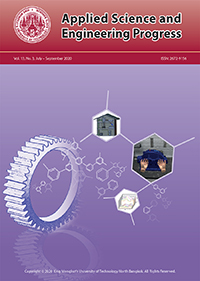A Structure Equation Model of Strategic Management for Driving Country Economy of Provincial Chamber of Commerce
Main Article Content
Abstract
Situations in the present world have been changed so much that they affect the overall economy of the country. Trade competitions are getting higher, causing the uniting of private businesses into Council of Chamber of Commerce, Federations of Thai Industries, Thai Chamber of Commerce, and Provincial Chamber of Commerce. When Provincial Chamber of Commerce is taken into consideration, it is found that some of them are not strong enough. Moreover, there are many management problems caused by executive committee. This study aimed to investigate strategic management and to develop a structure equation model for Provincial Chamber of Commerce. The qualitative data were collected via interviewing experts while the quantitative ones were collected from executive committee and members of Chamber of Commerce via questionnaire. The number of the samples in total was 500. The analysis showed that the developed structure equation model passed the evaluation criteria, and was consistent with the empirical data. Its Chi-square probability level, relative Chi-square value, goodness of fit index, and root mean square error of approximation were 0.209, 1.122, 0.976, and 0.016 respectively.
Article Details
References
[2] J. U. D. Akbar and Z. B. Ghazali, “The mediating influence of team alignment on the relationship between plant turnaround maintenance planning and plant turnaround maintenance performance,” International Journal of Economics and Financial Issues, vol. 6, no. 3, pp. 76–82, 2016.
[3] K. M. Bartol and D. C. Martin, Management, 3rd ed., New York: McGraw-Hill, 1997.
[4] C. Kangwansupapan, “Human capital: Factors boosting international entrepreneurs in ASEAN free trade era,” Journal of Business Administration, vol. 37, no. 142, pp. 1–15, 2014.
[5] L. Tan and J. Ding, “The frontier and evolution of the strategic management theory,” Nankai Business Review International, vol. 6, no. 1, 2015.
[6] P. Panpae, Leaders and Change Management. Bangkok, Thailand: Chulalongkorn University Book Center, 2012.
[7] W. Ajhan, “Development of efficient teamwork of personnel in Koh Lanta local administration, Krabi province a case study,” M.S. thesis, Faculty of Political Science, Bhuket Rajabhat University, 2014.
[8] S. Chaloeysab, Information Technology. Bangkok, Thailand: Urai Graphic, 2012.
[9] C. Maser, Decision-Making for a Sustainable Environment: A Systemic Approach. Florida: CRC Press, 2013.
[10] M. Argano, The Relationship between Leaders’ Personality, Traits and Organizational Commitment. California: CreateSpace, 2012.
[11] M. David and C. D. Sutton, Social Research: An Introduction. 2nd ed., London, England: SAGE, 2011.
[12] P. W. Corrigan and S. G. McCracken, Interactive Staff Training: Rehabilitation Teams that Work. New York: Springer Science and Business Media, 2013.
[13] R. L. Daft, The Leadership Experience, 6th ed., Massachusetts: Cengage Learning, 2015.
[14] P. Gupta, S. Prakash, and U. Jayaraman, It Infrastructure & Its Management. Tata: McGraw- Hill Education, 2010.
[15] A. L. Smith, Making the Connection. Florida: Xulon Press, 2011.
[16] H. Reschke and H. Schelle, Dimensions of Project Management. Munich: Springer Science and Business Media, 2013.
[17] T. Silpcharu, Research and Statistical Data Analysis via SPSS and AMOS. Nonthaburi, Thailand: Business R & D, 2017.
[18] E. R. Babbie, The Practice of Social Research, 14th ed., New York: Wadsworth, 2015.
[19] J. L. Arbuckle, IBM SPSS Amos 20 User’s Guide. New York: IBM, 2011.
[20] S. Sumethapiwat, “Marketing communication in Thailand 4.0 Era for sustainable development,” Journal of Western University, vol. 2, no. 2, pp. 110–117, 2016.
[21] T. Surinwarangkool, “Guidelines for information technology development to manage knowledge in medium business enterprises,” Suansunanta Rajabhat University, Bangkok, Thailand, 2555 (in Thai).
[22] K. Leithwood and V. N. Azah, “Characteristics of effective leadership networks,” Journal of Educational Administration, vol. 54, no. 4, pp. 409–433, 2016.
[23] C. Nakban, “Development of training curriculum development to enhance change leadership characteristics for electronics industrial business organizations,” Ramkhamhang University, Bangkok, Thailand 2015.
[24] E. Olsen, Strategic Planning For Dummies. Hoboken: Wiley Publishing, Inc., 2007.
[25] W. Kanjanapatee, “Leadership and followership affecting effectiveness of organizations: A case study of EXIM bank of Thailand,” M.S. thesis, Department of Business Management, Faculty of Business Management, Rajamangala University of Technology, 2556.
[26] R. L. Daft, The Leadership Experience, 4th ed., Florida: Harcourt, Inc., 2008.


